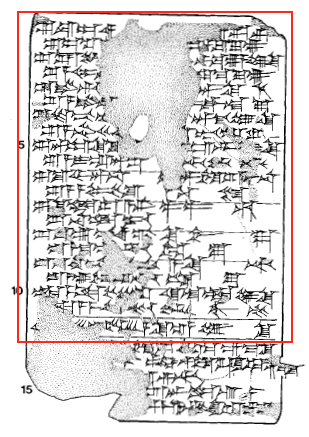Temples, Shrines, and Ziggurat of Kish

Obverse of BM 055476, a clay tablet with an explanatory temple list now in the Sippar collections of the British Museum (London). Lines 1–10 provide information about Kish's temples, city wall, New Year's temple, and ziggurat. Reproduced from George, House Most High, pl. 15.
A Neo-Babylonian explanatory temple list devoted to providing information about the topography of four northern Babylonian cities gives some details about Kish's holy buildings, as do several lists of temples and ziggurats. Edubba ("Storage House") was the temple of Kish's patron deity Zababa; EgišhurbiGALAM.GALAM ("House Whose Ordinances are Skilfully Contrived") was the New Year's temple; and Eunirkitušmah ("House, Temple-Tower, Exalted Abode"), which was sometimes called Eanurkitušmah ("House of the Foundation of Heaven, Lofty Abode"), was its ziggurat. The aforementioned texts also provide the names of five cellas in Edubba, in particular Emeteursag ("House, Worthy of the Hero") and Egalgasu ("House Filled with Counsel"), as well as the names of several other temples, including Esulimanna ("House of the Awesome Radiance of Heaven"), which was dedicated to the goddess Ištar in her manifestation as Bēlet-Eanna ("Lady of Eanna").
Alphabetical list of temples at Kish
- Eakkil: temple of the god Ninšubur
- Eazbzukuga: cella of the god Zababa
- Eanurkitušmah: variant name of the ziggurat
- Edubba: temple of the god Zababa
- Edukuga: a sanctuary of the god Zababa
- Egalgasu: cella of the goddess Baba
- EgišhurbiGALAM.GALAM: New Year's temple
- Einimkuga: a sanctuary of the god Zababa
- Ekiaggani: a cella (probably in Esulimanna)
- Ekitušgalanna: a temple
- Ekiš[...]: a temple
- Emeteursag: cella of the god Zababa
- Emuš[...]: a temple
- Enitakalagga: a temple (perhaps at Kish)
- Erabriri: cella of the god Madānu
- Esilim[...]: a temple
- Esulimanna: temple of the goddess Ištar (as Bēlet-Eanna)
- Ešulanna: a sanctuary of the god Zababa
- Ešuluhbikuga: courtyard (probably of Esulimanna)
- Etemenbinukur: cella of the goddess Bēlet-Kiš ("Lady of Kish")
- Eunirkitušmah: ziggurat
Jamie Novotny
Jamie Novotny, 'Temples, Shrines, and Ziggurat of Kish', Babylonian Temples and Monumental Architecture online (BTMAo), The BTMAo Project, a sub-project of MOCCI, [http://oracc.org/btmao/Kish/TemplesandZiggurat/]